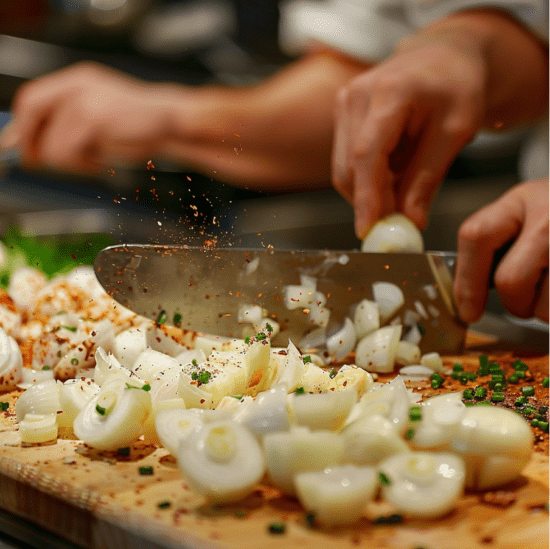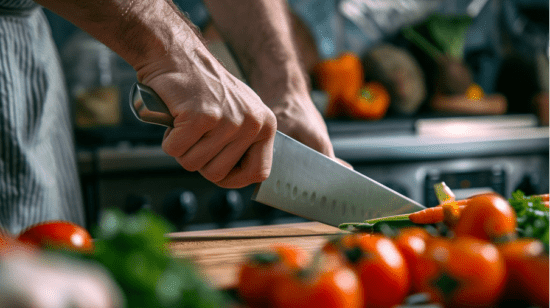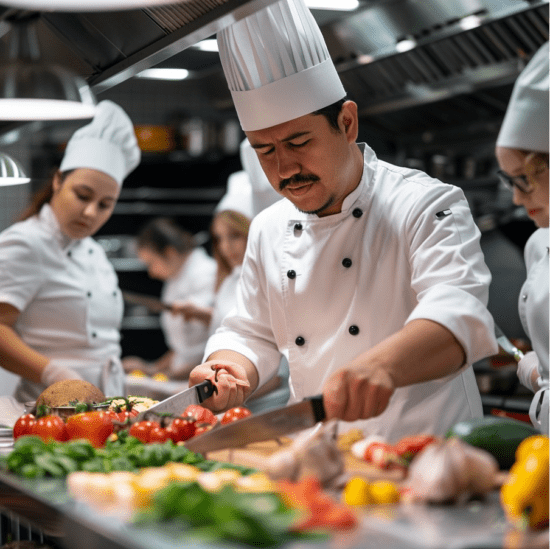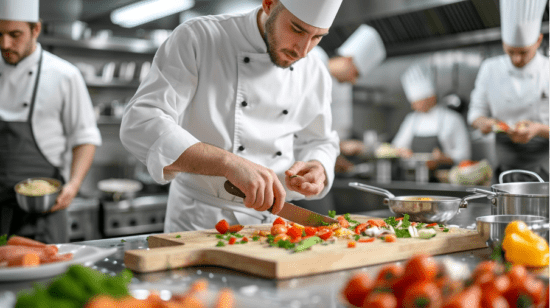We’ve all seen the impressive knife skills on 24Kitchen. You know the ones when the chief’s knife slowly glazes, basically caressing the onions or carrots, and they come out perfectly chopped.
Well, perfecting your skill isn’t easy, no matter what skill it is. And your knife skills are CRUCIAL if you want to be a chief. You need to know the whats and hows, the dos and don’ts. But don’t worry.
We’ll get into all that in today’s article. Let’s get to it.

Source: StockCake
Contents
Why are Your Knife Skills So Important?
Every part of the kitchen needs to function perfectly in order to execute the flawless meal. Restaurant jobs may seem easy, but you need a lot of thought and skill to be a part of the kitchen. Here’s why knife skills are important:
- Efficiency and speed: In a professional kitchen, time is important. Good knife skills mean you can prepare all the ingredients quickly. Being able to chop up some groceries in no time can save you a lot of time in this environment.
- Consistency and presentation: Evenly cut food slices ensure that everything cooks equally and looks presentable.
- Safety: Knowing the correct way to hold and use a knife minimizes the possibility of accidents in the kitchen. A sharp knife is actually safer than a dull one because it requires less force to cut.
- Maximizing ingredient use: Good knife skills can help minimize waste by making sure you make more precise cuts. This means you can get the most out of your ingredients.
- Professionalism: Proper knife skills show that you are a professional. They demonstrate that you have had the right training and that you take pride in your work. It’s an important skill to have that sets experts apart from amateurs.

Source: StockCake
Knife Techniques You Need to Know
Cutting is all about using the right technique. Here are some you should know:
1. The Claw Grip
The claw grip is a vital technique. You need to tuck your fingers under, like you are trying to form them into a claw, while holding the food. This grip keeps your fingers safe and helps you control the knife better.
2. Chopping
Chopping involves cutting food into smaller pieces. You can cut them into any size you need for the dish. The key is to keep your pieces the same size for even cooking.
3. Dicing
Dicing is a more precise form of chopping where food is cut into small, equal-sized cubes. This technique is usually used for vegetables (onions, tomatoes, potatoes, and so on).
4. Julienne
Julienne involves cutting food into long, thin strips. This technique is often used for vegetables like carrots, bell peppers, and zucchini, and is perfect for stir-fries or salads.
5. Brunoise
Brunoise is an even finer version of dicing, where the food is cut into tiny cubes, usually about 1/8 inch or 3mm on each side. This technique is often used for garnishes and small ingredients in sauces or soups.
6. Mincing
Mincing is cutting food into very small pieces. Garlic and herbs are often minced to release their flavors more effectively into the dishes. Mincing requires a lot of control in order to achieve uniformity and avoid over-chopping.
7. Chiffonade
Chiffonade is a technique used for leafy vegetables and herbs, where leaves are stacked, rolled, and then sliced into thin ribbons. This method is perfect for decoration.

Source: StockCake
Tips on How to Improve
Improving your knife skills takes a lot of practice and patience. Here are some tips that can help you get better:
1. Choose the Right Knife
Invest in a high-quality knife and keep it sharp. A sharp blade makes cutting easier, and it’s safer to use. Different knives serve different purposes, so learn more about the types of knives and when to use each type.
Here are some examples:
- A chef’s knife is used for chopping, slicing, dicing, and mincing a lot of foods, like vegetables, meat, and herbs. It’s the go-to knife for most tasks in the kitchen.
- A paring knife is a small knife with a blade usually 3 to 4 inches long. It is used for peeling, trimming, and precise cutting jobs, like deveining shrimp, seeding jalapenos, or creating garnishes.
- A serrated knife or bread knife is a knife with a long blade and serrated edge, typically 8 to 10 inches long. Chefs use it for cutting through foods with a hard exterior and soft interior (like bread, tomatoes, and cakes). The serrated edge helps slice through without crushing the food.
- The boning knife is a thin, flexible blade, usually 5 to 7 inches long. It is used for removing bones from meat, poultry, and fish.
2. Start Simple
Start with simple techniques like the claw grip or basic chopping. Practice these until you feel comfortable before moving on to the more complicated ones.
3. Use a Stable Cutting Surface
Always use a cutting board that doesn’t slip. A damp cloth underneath can help prevent movement and provide a stable surface for you. This also makes cutting safer.
4. Take Your Time
Speed comes with practice. First, master the easy techniques. Take your time to make sure your cuts are all the same size. As you become more comfortable and experienced, you’ll be able to cut more quickly.
5. Watch the Professionals
Watching how experienced chefs do it can be very helpful. Watch cooking shows, tutorials, or even think about taking a knife skills class. Seeing experts in action can give you a lot of insights and help you learn how it’s done.

Source: StockCake
6. Keep Your Knife Sharp
Sharpen your knife as necessary and hone it on regularly with a honing steel. A dull blade requires more force and can be more dangerous than a sharp one. Keeping your knife sharp is an important step for both efficiency and safety.
7. Practice Makes Perfect
Like any skill, practice is key. The more you use your knife, the more familiar and comfortable you’ll become with it. Practice with different types of foods, one technique at a time.
The Bottom Line
So, there you have it. In order to master your skills, you need to have patience and take it one step at a time.
Your knife skills are an important contribution to the kitchen, and it’s necessary to think about staying safe. It doesn’t matter how long it takes you to perfect your craft. What matters is that you get there. Knowing this skill will elevate the quality and presentation of your dishes.
Just remember to know your knives and cutting techniques, and regularly sharpen your knife. We wish you luck in the cutting game. You’ve got this.
